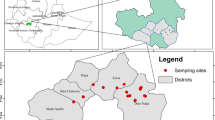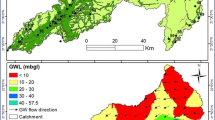Abstract
A pilot study was completed in the Al-Abyad area near phosphate mining activity in Jordan. Six plots of 50 m2 each were planted with two types of plant species (Zea mays spp. and Medicago lupulina spp.) and irrigated using three types of water (fresh groundwater, mine wastewater, and hydride water consisting of 50% fresh and 50% mine wastewater) to investigate the suitability of utilizing mine wastewater for food production in the area. Water, soil and plant sampling was completed for each plot over different time intervals and analyzed for heavy metal (Cr+6, Ni+2, Zn+2 and Pb+2) in addition to major ionic composition of the water used for irrigation. Crop yield was estimated at the end of the experiment. Plots irrigated with mine wastewater showed slightly higher heavy metals concentrations and soil salinity during the experiment period was higher for plots irrigated with mine wastewater compared to plots irrigated with fresh water, and it was uniform through the upper 45 cm of the soil profile due to the high amount of irrigation water used during the experiment. Crop yield was inversely proportional to salinity as an increase of salinity by 2-folds resulted in reducing yield by almost 50%. However, no risk of heavy metals contamination was found in plants and soil.




Similar content being viewed by others
References
Abreu, M. M., Matias, M. J., Clara, M., Magalhães, F., & Basto, M. J. (2007). Impacts on water, soil and plants from the abandoned Miguel Vacas copper mine, Portugal. Journal of Geochemical Exploration (Article in Press).
Abu-Jaber, N. S., (1993). Uniformitarian geochemical constraints on the genesis of Jordanian Tethyan phosphorites. Mu’tah Journal for Research and Studies-Applied and Natural Sciences Series, 8(4), 301–322.
Caron, J., Ben Jemia, S., Gallichand, J., & Trépanier, L. (1999). Field Bromide transport under transient-state monitoring with time domain reflectometry and porous cup. Soil Science Society of America Journal, 63, 1544–1553.
Didier, V. L., Mench, M. J., Gomez, A. N., & Lambrot, C. (1997). Use of inorganic amendments for reducing metal bioavailability to ryegrass and tobacco in contaminated soils. In A. Iskandar, D. C. Adriano (Eds.), Remediation of soils contaminated with metals (pp. 85–98). Northwood, UK: Science Reviews.
El-Hasan, T. (2006). Geochemical dissociation of major and trace elements in bed and suspended sediment phases of the phosphate mines effluent water, Jordan. Environmental Geology, 51(4), 621–629.
Ghosheh, A., & Dodeen, F. (1993). Heavy metals in Jordanian phosphate rocks. In Proceeding of the 4th International Fertilizer Seminar, Amman, p. 36.
Hatira, A., Chokri, A., Zerai, N., Saadi, A., Rada, A., & El-Meray, M. (2005). Heavy metal concentration of soil and plants near the phosphate treatment industry, Tunisia. Water, waste and Environmental Research, 5(2), 43–50.
Jiries, A., El-Hasan, T., Hweiti, M., & Seiler, K.P. (2004). Water quality of effluent from phosphate mining activity–central Jordan. Mine water and Environment, 23(3), 133–137.
Mercuri, A. M., Duggin, J. A., & Grant, C. D. (2005). The use of saline mine water and municipal wastes to establish plantations on rehabilitated open-cut coal mines, Upper Hunter Valley NSW, Australia. Forest Ecology and Management, 204(2–3), 195–207.
Minkina, T. M., Samokhin, A. P., & Nazarenko, O. G. (2006). Translocation of heavy metals in soil-plant system in plant nutrition in food security and sustainability of agro-ecosystems through basic and applied research (Vol. 92, pp. 360–361). Netherland: Springer Verlag.
Sadaqa, R., Abed, A., Grimm, K., & Pufahl, P. (2001). Oxygen and carbon isotopes in the Jordanian phosphorites and associated fossils. In: Proceeding of the 7th Jordan Geological Conference (Book of abstract), 81 pp.
Saeed, M., & Fox, R. L. (1979). Influence of phosphate fertilization on zinc adsorption by tropical soils. Soil Science Society of American Journal, 43, 683–686.
Acknowledgments
The author is grateful to Prof. Arden Davis from SDSM&T and Prof. Berdanier Bruce from Ohio Northern University for their help in editing and scientific discussion.
Author information
Authors and Affiliations
Corresponding author
Additional information
Readers should send their comments on this paper to: BhaskarNath@aol.com within 3 months of publication of this issue.
Rights and permissions
About this article
Cite this article
Rimawi, O., Jiries, A., Zubi, Y. et al. Reuse of mining wastewater in agricultural activities in Jordan. Environ Dev Sustain 11, 695–703 (2009). https://doi.org/10.1007/s10668-007-9137-9
Received:
Accepted:
Published:
Issue Date:
DOI: https://doi.org/10.1007/s10668-007-9137-9




